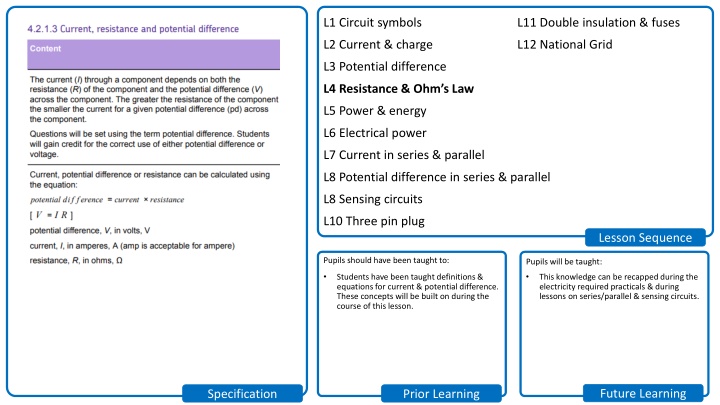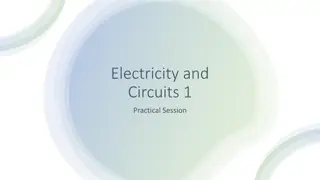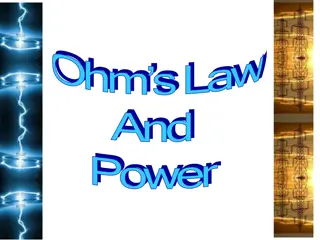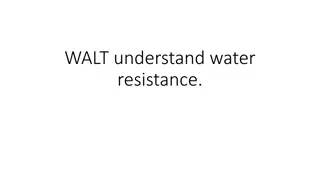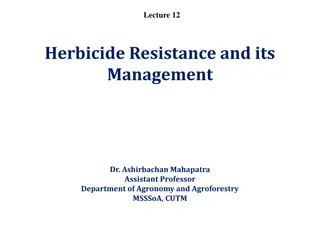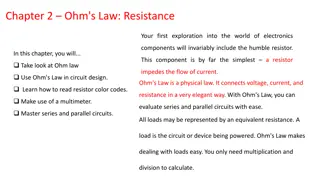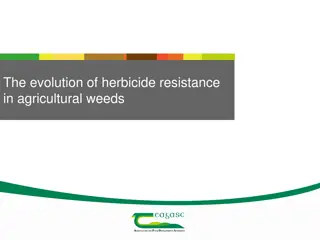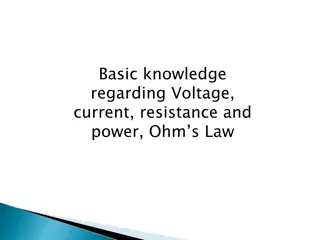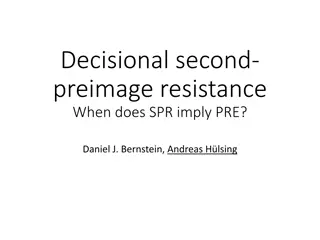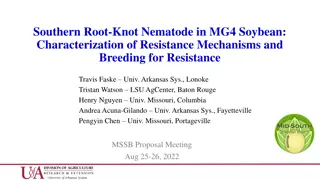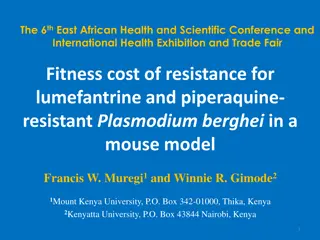Resistance and Ohm's Law
Resistance is a fundamental concept in circuits, impacting current flow and potential difference. Ohm's Law states that current is proportional to potential difference in a component, provided temperature remains constant. Explore the causes and implications of resistance in circuits through practical examples and theoretical discussions.
Download Presentation

Please find below an Image/Link to download the presentation.
The content on the website is provided AS IS for your information and personal use only. It may not be sold, licensed, or shared on other websites without obtaining consent from the author.If you encounter any issues during the download, it is possible that the publisher has removed the file from their server.
You are allowed to download the files provided on this website for personal or commercial use, subject to the condition that they are used lawfully. All files are the property of their respective owners.
The content on the website is provided AS IS for your information and personal use only. It may not be sold, licensed, or shared on other websites without obtaining consent from the author.
E N D
Presentation Transcript
L1 Circuit symbols L11 Double insulation & fuses L2 Current & charge L12 National Grid L3 Potential difference L4 Resistance & Ohm s Law L5 Power & energy L6 Electrical power L7 Current in series & parallel L8 Potential difference in series & parallel L8 Sensing circuits L10 Three pin plug Lesson Sequence Pupils should have been taught to: Pupils will be taught: Students have been taught definitions & equations for current & potential difference. These concepts will be built on during the course of this lesson. This knowledge can be recapped during the electricity required practicals & during lessons on series/parallel & sensing circuits. Future Learning Specification Prior Learning
SciDoc Resistance Resistance Last Lesson Last Term Last Year Stretch & Challenge I do We do You do Test I do We do You do Do Now
SciDoc Keywords Learning Objectives Keywords Resistance Current Potential Difference Ohms Recall common prefixes. Recall what causes resistance & the definition of Ohm s law. Calculate resistance, current and potential difference. I do We do You do Test I do We do You do Do Now
Prefixes: Stick the following on the inside cover of your book. SciDoc Prefix Giga Mega Kilo Centi Milli Micro Nano Symbol G M k c m n Value 109 106 103 10-2 10-3 10-6 10-9 Expanded value 1 000 000 000 1 000 000 1 000 0.01 0.001 0.000 001 0.000 000 001 I do We do You do Test I do We do You do LO:
SciDoc Questions (5 mins) Questions (5 mins) 1. Convert 0.7 kV to V. 2. Convert 5 MV to V. 3. Convert 0.1 mV to V. 4. Convert 1,500 V to kV. 5. Convert 2,700,000 to MV 6. Convert 700,000,000 to GV. I do We do You do Test I do We do You do LO:
Resistance is a measure of how hard it is for the current to pass through a component in a circuit. SciDoc The higher the resistance of a component the harder it is for the current to pass through that component. Stretch: What causes resistance in a conductor? Moving electrons can collide with the ions in the metal. This makes it more difficult for the current to flow, and causes resistance. I do We do You do Test I do We do You do LO:
Image result for filament bulb graph Ohm s lawstates that the current through a resistor is proportional to the potential difference provided that the temperature is constant. SciDoc Stretch: The graph opposite is for a filament lamp. Is it Ohmic (following Ohm s law) or non-Ohmic? What happens to the resistance of the filament lamp as the current increases? Why? I do We do You do Test I do We do You do LO:
V = I x R you must remember this equation! Where: I current in amps (A) V voltage in volts (V) R resistance in ohms ( ) SciDoc Stretch Re-arrange the equation above to get equations for I and R. I do We do You do Test I do We do You do LO:
SciDoc Worksheet Worksheet Complete the worksheet! I do We do You do Test I do We do You do LO:
SciDoc Basic answers Basic answers BASIC: 1. a) V = I R = 8 10 = 80 V b) V = I R = 5 2.5 = 12.5 V c) V = I R = 10 0.2 = 2 V 2. a) I = V R = 20 10 = 2 A b) I = V R = 10 20 = 0.5 A c) I = V R = 0.2 5 = 0.04 A 3. a) R = V I = 20 4 = 5 b) R = V I = 10 20 = 0.5 c) R = V I = 5.5 15.5 = 0.35 I do We do You do Test I do We do You do LO:
SciDoc Medium answers Medium answers MEDIUM: 1. I = 1000 mA = 1 A V = I R = 1 5 = 5 V 2. V = 100 mV = 0.1 V I = V R = 0.1 2.5 = 0.04 A 3. I = 20 mA = 0.02 A V = 10 mV = 0.01 A R = V I = 0.01 0.02 = 0.5 I do We do You do Test I do We do You do LO:
SciDoc Hard answers Hard answers HARD: 1. R = V I = 230 10 = 23 2. I = V R = 12 60 = 0.2 A 3. R = V I = 230 5 = 46 4. I = V R = 4.5 15 = 0.3 A 5. I = V R = 6 4 = 1.5 A 6. a) R = V I = 3 0.2 = 15 b) I = V R = 1.5 15 = 0.1 A c) Torch will have less current therefore less bright. 7. I = 100 mA = 0.1 A 8. R = 5 k = 5,000 , I = 18 mA = 0.018 A V = I R = 0.1 120 = 12 V = I R = 0.018 5,000 = 90 V I do We do You do Test I do We do You do LO:
SciDoc Stretch questions Stretch questions Complete the harder questions! I do We do You do Test I do We do You do LO:
SciDoc Stretch Answers Stretch Answers 2. Calculate total resistance first R = V I = 6 2 = 3 3 1 = 2 for the two resistors each resistor has 1 resistance 3. R = V I = 6 1.5 = 4 4. Resistance is a measure of how hard it is for the current to pass through a component in a circuit. 5. a) V = I R = 0.36 10 = 3.6 V b) V = I R = 0.36 15 = 5.4 V c) Total voltage = 3.6 + 5.4 = 9.0 V R = V I = 9 0.36 = 25 I do We do You do Test I do We do You do LO:
SciDoc Struggle time! (8 mins) Struggle time! (8 mins) The graph below shows how the resistance of a thermistor varies with temperature. Use this to help answer part d). I do We do You do Test I do We do You do LO:
SciDoc I do We do You do Test I do We do You do LO:
SciDoc I do We do You do Test I do We do You do LO:
